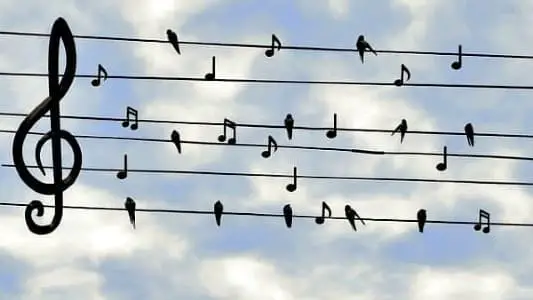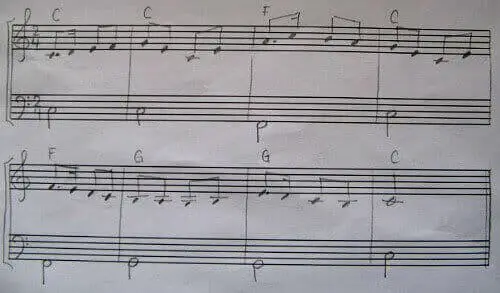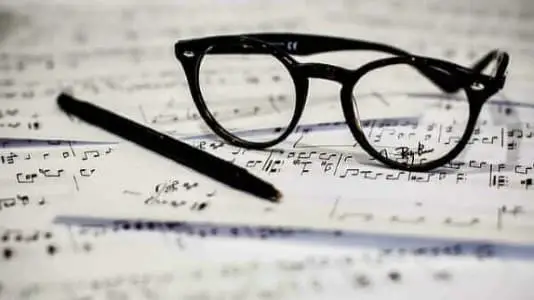- Home
- How to Write Music
- 4 Part Harmony
Easy 4 Part Harmony for Beginners
This article may contain compensated links. Please read the disclosure for more info.
Learn how to use simplified rules for 4 part harmony writing to compose your very own piece in this free music composition lesson!
Getting started
In two previous lessons on how to write music for beginners, you learned; 1) how to write a melody and 2) how to add a chord sequence to that melody.
This is all we need to make a great little mini-composition! :) In this lesson you will continue to learn how to arrange your little piece for 4 parts or "voices".
Simple, easy-peasy 4 part harmony does not have to be complicated.
Unless you get stuck in following the rules too much, or by focusing more on analysis than practical and creative work...
(Analysis can be fun, and challenging too, but here we will focus on simply making some music that sound fine with minimal effort and music theoretical knowledge!)
OK. Here we go!

How to write simple 4 part harmony step by step
When you write 4 part harmony you need to think about the music both vertically and horizontally.
- Horizontally you will create 4 different "voices" or parts. These parts are called (from the highest pitch to the lowest); soprano, alto, tenor and bass.
- Vertically the 4 parts will create harmony, since you will use a note from your melody and the 3 notes from the chord supporting the melody. When played at the same time this creates harmony- 4 part harmony.
Write it!
Step 1: Group 2 staff lines together with a bracket. The top staff with a treble clef for the soprano and alto, and the bottom staff with a bass clef for the tenor and bass.
Step 2: Write your melody on top, draw all the stems up. This is for the «soprano» or a high pitched instrument.
Step 3: Add the chord symbols (C, F, G).

Step 4: Draw all the bass (root) notes from your chords. (That is C from the C chord etc.) Stems down. This is the «bass» or the low pitched instrument you're writing for.

Handy Tip
Let the bass move in contrary (opposite) direction of the melody if possible; if the melody moves up, let the bass go down and vice versa.
Step 5: Time to fill in the other notes from each chord.
Since there are only 3 notes in each chord, and we are writing for 4 different «parts», we will double the root, or the bass note from each chord to get 4.
So, let's look at the score. Hmm...
We have already written two parts. The top note in this example is a C, and the bass is also a C. So, what notes are missing from the first chord?
Right! E and G.
I will try to put G in the second voice, or «alto». Stems down (to help separate the voices visually).
I will give the "tenor" an E. I’ll choose low E for now, since I would cross over the soprano otherwise (and she'd be crossed!: )). Stems up.
Step 6: Next chord. Now, stick to a very easy rule and you will keep a nice smooth sound going:
When selecting the next note for each part, try to use the smallest movement possible. Stay on the same note if you can. Be super lazy! The best is to keep the alto and tenor part very «boring».... For now!
In our example the next chord is the Tonic again, in this case a C major chord. The melody has a G, and the bass a C. What’s missing?
Right! Another C (double the root) and an E. The tenor has an E, I'll keep that, but "unfortunately" the alto has to jump a fourth to a C. It is OK, though.

Some basic rules...
- Let the four parts move in different directions (up, down or same note) if possible, even if only one does it’s OK.
- According to the rules of 4 part harmony, or Bach Choral style writing, thou shalt not have any parallel fifths, fourths or octaves... (This means any 5th, 4th or octave intervals moving to another of the same.)
OK, alright. I like parallel fifths and fourths (just think about the famous intro riff in «Smoke on the water») but for this exercise we’ll stick to the rules. Later, use what you want- and with abandon if you like!
So watch out for any parallel movement: Are there any hard rockers there? If there are, switch the alto and tenor notes, or change the octave they are in, but don’t change the melody or the bass.
Step 7: The next chord is a Subdominant, or an F major chord. I have A in the melody and F in the bass. I need another F and a C. So, the alto stays on C and the tenor lazily moves a semitone to F. Great!
Continue like this until the end of the melody. (It’s a bit like knitting, isn’t it?)
Check the pattern and how each part moves: As smooth as possible, contrary motion if possible, and no parallel 5ths, 4ths or Octaves.
Done!
This was an example of super-simple 4 part harmony. And if you followed along from lesson 1 and lesson 2, you have now you own little composition in your hand. I bet you did it snazzier than the crumpled example above! : )
Play It!
Now the fun part (and the reward for your hard work!): You can play or sing through each part, and if you play the piano you can play all at the same time.
If you don't have friends who play different instruments handy, it is great fun to record each part as a separate instrument. You can do this in a notation program, or on a piano keyboard (I use my digital piano where I can record different tracks).
Record each part on a separate track, and then listen to your 4 part harmony composition... impressive!
TIP: You could also do this exercise by borrowing a melody and chords from someone else. This is quite OK to do as an exercise, as long as you don’t call it your own composition.
If it would turn out to be a fantastic arrangement that you want to make public or sell, you have to ask the composer for permission of course.
So, how did it go? Sounded good? Great! Fun, wasn't it?
Learn More Harmony
For more in depth learning of 4part harmony, I recommend these two resources:
Four-Part Harmony, Volume One ,and Four-Part Harmony, Volume Two.
They're a clear and easy to understand introduction to writing classical four part harmony.







